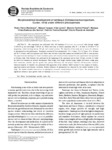Use este identificador para citar ou linkar para este item:
http://www.alice.cnptia.embrapa.br/alice/handle/doc/929134Registro completo de metadados
| Campo DC | Valor | Idioma |
|---|---|---|
| dc.contributor.author | MENDONÇA, P. P. | pt_BR |
| dc.contributor.author | VIDAL JUNIOR, M. V. | pt_BR |
| dc.contributor.author | POLESE, M. F. | pt_BR |
| dc.contributor.author | SANTOS, M. V. B. dos | pt_BR |
| dc.contributor.author | REZENDE, F. P. | pt_BR |
| dc.contributor.author | ANDRADE, D. R. de | pt_BR |
| dc.date.accessioned | 2012-07-24T11:11:11Z | pt_BR |
| dc.date.available | 2012-07-24T11:11:11Z | pt_BR |
| dc.date.created | 2012-07-24 | pt_BR |
| dc.date.issued | 2012 | pt_BR |
| dc.identifier.citation | Revista Brasileira de Zootecnia, Viçosa, MG, v. 41, n. 6, p. 1337-1341, jun. 2012. | pt_BR |
| dc.identifier.uri | http://www.alice.cnptia.embrapa.br/alice/handle/doc/929134 | pt_BR |
| dc.description | The experiment was performed with 160 tambaqui (Colossoma macropomum) with average weight 11.01±2.08 g and total length 7.8±0.18 cm. Fishes were kept in sixteen aquariums with 56 L of water at 29.1±0.4 oC of temperature, initial stocking density 1.97 g/L and constant aeration. The objective of this study was to assess the influence of photoperiod on fish performance. Treatments consisted of four photoperiods: T1 = 6 hours; T2 = 12 hours; T3 = 18 hours and T4 = 24 hours, with four replicates each. Fishes were fed twice a day with commercial extruded feed (28% of crude protein). The experiment was developed in closed circulation system, with volume of water renewal for each experimental unit equivalent to 40 times daily. Fish biometry was performed at the beginning of the experiment and at every 16 days, in order to follow the effects of treatments on juvenile development. Final weight, total length, standard length, height, feed intake, weight gain, feed conversion, survival, specific growth rate, protein efficiency rate and protein retention efficiency were assessed. Statistical analysis of variables was performed with application of the software SAEG version 9.1, for analysis of variance, regression analysis and Pearson correlation. Positive influence of photoperiod was observed for the studied variables in this study. The studied variables enhanced as the photoperiod increased, mainly between 15 and 22 hours. The photoperiod has significant influence upon growth traits of tambaqui (Colossoma macropomum). | pt_BR |
| dc.language.iso | eng | eng |
| dc.rights | openAccess | eng |
| dc.title | Morphometrical development of tambaqui (Colossoma macropomum, Cuvier, 1818) under different photoperiods. | pt_BR |
| dc.type | Artigo de periódico | pt_BR |
| dc.date.updated | 2012-08-21T11:11:11Z | pt_BR |
| dc.subject.thesagro | Peixe de água doce | pt_BR |
| dc.subject.thesagro | Bioclimatologia | pt_BR |
| dc.subject.thesagro | Tambaqui | pt_BR |
| dc.subject.thesagro | Colossoma macropomum | pt_BR |
| dc.subject.nalthesaurus | Fish | pt_BR |
| dc.subject.nalthesaurus | Bioclimatology | pt_BR |
| riaa.ainfo.id | 929134 | pt_BR |
| riaa.ainfo.lastupdate | 2012-08-21 | pt_BR |
| dc.contributor.institution | PEDRO PIERRO MENDONÇA, doutorando UENF; MANUEL VAZQUEZ VIDAL JUNIOR, UENF; MARCELO FANTTINI POLESE, mestrando UENF; MONIQUE VIRÃES BARBOSA DOS SANTOS, mestranda UENF; FABRICIO PEREIRA REZENDE, CNPASA; DALCIO RICARDO DE ANDRADE, UENF. | pt_BR |
| Aparece nas coleções: | Artigo em periódico indexado (CNPASA)  | |
Arquivos associados a este item:
| Arquivo | Descrição | Tamanho | Formato | |
|---|---|---|---|---|
| rbz.pdf | 99,19 kB | Adobe PDF |  Visualizar/Abrir |









